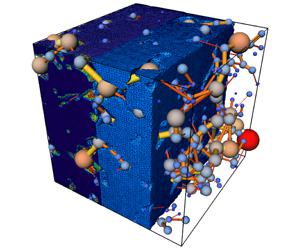当前位置:
X-MOL 学术
›
J. Fluid Mech.
›
论文详情
Our official English website, www.x-mol.net, welcomes your
feedback! (Note: you will need to create a separate account there.)
Coupling pore network and finite element methods for rapid modelling of deformation
Journal of Fluid Mechanics ( IF 3.6 ) Pub Date : 2020-06-15 , DOI: 10.1017/jfm.2020.381 Samuel Fagbemi , Pejman Tahmasebi
Journal of Fluid Mechanics ( IF 3.6 ) Pub Date : 2020-06-15 , DOI: 10.1017/jfm.2020.381 Samuel Fagbemi , Pejman Tahmasebi

|
Numerical modelling of deformation in hydromechanical systems can be time-consuming using fully coupled classical numerical methods for large representative porous media samples. In this paper, we present a new two-way coupled partitioned fluid–solid system. The coupled system is applied for simulating geomechanical processes at the pore-scale. We track the deformation of the solid resulting from the drainage of resident fluids in the pores, as well as the evolution of fluid properties from dynamic loading. The finite element method is responsible for capturing the structural deformation in the coupled system while the dynamic pore network is used for modelling multiphase flow in the fluid subsystem. A fictitious fluid–solid interface is created at each pore network-finite element node junction via convex hulling, followed by data exchange using linear interpolation. The results show good agreement with a pre-existing coupled finite volume model and the computations are completed in much less time.
中文翻译:

耦合孔隙网络和有限元方法,用于快速建模变形
对于大型代表性多孔介质样品,使用完全耦合的经典数值方法对流体力学系统中的变形进行数值建模可能非常耗时。在本文中,我们提出了一种新的双向耦合分区流固系统。耦合系统用于模拟孔隙尺度的地质力学过程。我们跟踪因孔隙中驻留流体的排出而导致的固体变形,以及动态载荷对流体特性的演变。有限元方法负责捕捉耦合系统中的结构变形,而动态孔隙网络用于模拟流体子系统中的多相流。通过凸包在每个孔隙网络-有限元节点连接处创建一个虚构的流体-固体界面,然后使用线性插值进行数据交换。结果显示与预先存在的耦合有限体积模型非常吻合,并且计算在更短的时间内完成。
更新日期:2020-06-15
中文翻译:

耦合孔隙网络和有限元方法,用于快速建模变形
对于大型代表性多孔介质样品,使用完全耦合的经典数值方法对流体力学系统中的变形进行数值建模可能非常耗时。在本文中,我们提出了一种新的双向耦合分区流固系统。耦合系统用于模拟孔隙尺度的地质力学过程。我们跟踪因孔隙中驻留流体的排出而导致的固体变形,以及动态载荷对流体特性的演变。有限元方法负责捕捉耦合系统中的结构变形,而动态孔隙网络用于模拟流体子系统中的多相流。通过凸包在每个孔隙网络-有限元节点连接处创建一个虚构的流体-固体界面,然后使用线性插值进行数据交换。结果显示与预先存在的耦合有限体积模型非常吻合,并且计算在更短的时间内完成。











































 京公网安备 11010802027423号
京公网安备 11010802027423号